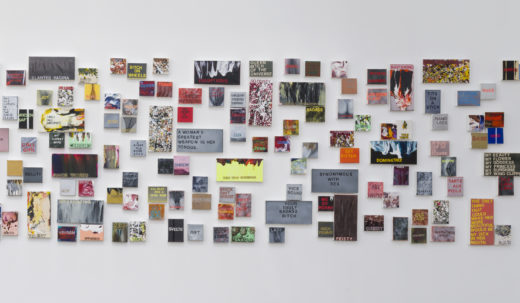- Under the water was sand, then rocks, miles of rocks, then fire

- A JAMBOREE OF HOODLUMS: Wallace Stevens on Miami
Betty Tompkins: Sex World/WOMEN Words, Phrases, and Stories
Erica Ando

Betty Tompkins: Sex World/Women Words, Phrases, and Stories, Gavlak Palm Beach, January 6-February 3, 2017. Photo: Jeff McLane
JANUARY 6-FEBRUARY 3, 2017
Betty Tompkins has always been ahead of the game, but she could not have known, when she began her WOMEN Words project in 2002 that “pussy” would become a catalytic term during the 2016 American Presidential campaign. Then again, good timing has eluded the 71-year-old artist throughout her career. Though most well known for Fuck Paintings (1969–74), a series of large-scale photorealistic works of heterosexual sex acts rendered close up, this renown began only in the early 2000s, and even then, erratically. Censored in France and Japan (in the latter, required to make a case for her work “as art” in order to eventually retrieve it), rejected by second-wave, anti-pornography feminists and feminist artists, and deleted outright on Twitter and Instagram, Tompkins has long been slut-shamed for work that occupies the extreme fringes of feminist art.
WOMEN Words started as an e-mail survey. “I am considering doing a series of pieces using images of women comprised of words,” she wrote, to both women and men. “I would appreciate your help in developing the vocabulary. Please send me a list of words that describe women.” Of the approximately 1,500 responses she received, the four most popular words were “bitch,” “slut,” “cunt,” and “mother.” Revisiting the survey in 2013, she received more than 3,500 responses in seven languages. The most popular words? “Bitch,” “slut,” “cunt,” and “mother.”
Tompkins made 1,000 small paintings in this series, 350 of which are shown at Gavlak Palm Beach. Each work contains a crowd-sourced word or phrase in a neutral, sans-serif font. Recognizable styles of iconic male artists like Jackson Pollock, Gerhard Richter, and Lucio Fontana provide “painterly” backgrounds for the words. “Three hole wonder,” “prick pit,” and “vile labia lard” are some of the more pejorative ones, while potentially affectionate words like “beauty” and “badass” exude irony. Hung close to one another, the paintings recall foul Valentine’s Day candy hearts or mini, malevolent Ed Ruscha works—not contemplative works of art, but reminders of virulent female objectification.
Considering that the President of the United States has used some of these degrading terms to describe women, paintings in a gallery can seem to be a mere echo of a larger, more consequential world. Tompkins proposes, however, that reversing the point of view can convert normalized misogyny into a counterpunch. Current widespread feminist cooption like “pussy hats” that “grab back” or the reinvigorated “nasty woman” remark, apply Tompkins’s strategy of inverting the monopoly on who gets to say or do what. As she has done for years, Tompkins reclaims derogatory vocabulary and finds an alternative voice, injecting new power into words and images that threaten to become normalized.









